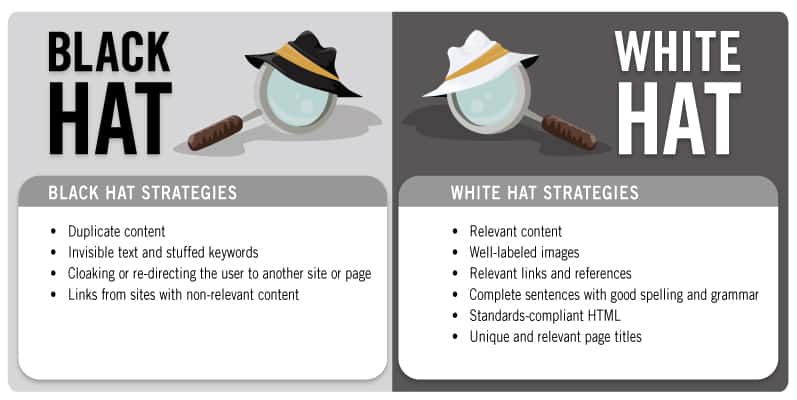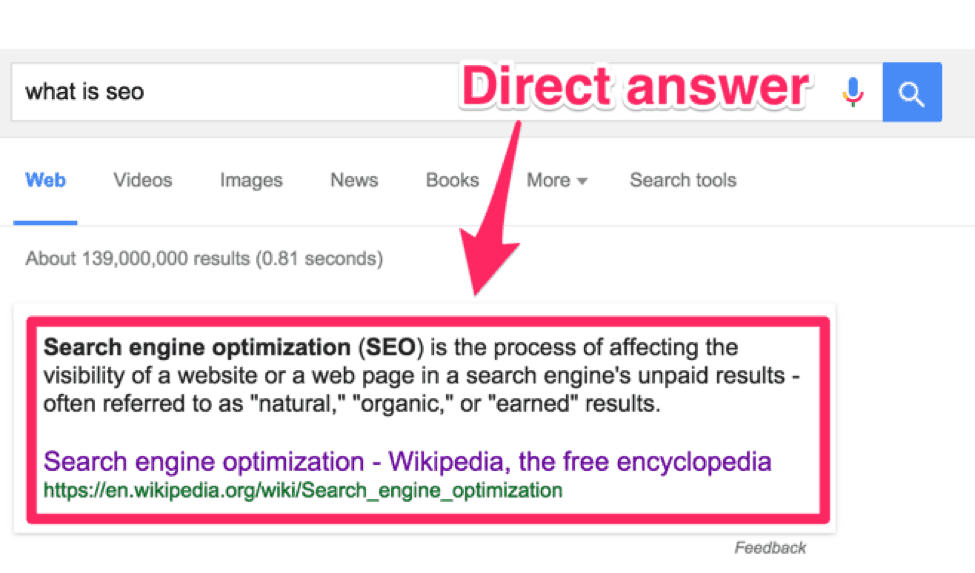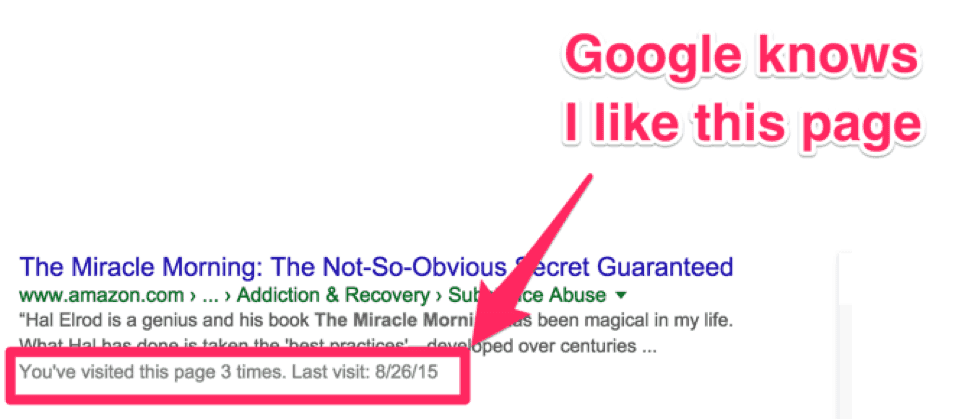
More than 2 million articles are published daily. In other words, 46 people will have published what they wrote by the time you finish this paragraph.
As you can expect, in a sea full of blog posts, yours might be difficult to stand out from the rest. If your blog is to be successful, it needs to separate itself from others like it.
Although I usually spend between 4 and 5 hours authoring my blog articles, the 10 minutes spent on optimizing all my posts are without question the most vital.
It’s hardly a surprise that millions of people type “SEO” into search engine field every month.
In a climate where more than 90% of experiences online begin with a search engine, being front-and-center on Google’s first page can be what determines if a business will go bankrupt or flourish.
What is the definition of SEO, though?
Of course, you know it means search engine optimization, but exactly does that entail?
SEO is all about how a website is seen on search engines without paying for placement.
SEO maximizes the content you have on the Internet for the purposes of search engines finding what people are looking for quickly and easily. The intention of SEO is to make sure the things you want to rank for can be seen on the top of search engine result pages (SERPs).
Let’s dissect that even more:
You are in the process of doing SEO work. The search engine is waiting for you to finish so a searcher can find you. If you have a blog post discussing how to make vegan lasagna, the search engine (which is Google 90% of the time) should showcase your article at the top of the listings for someone who Googles “vegan lasagna.”
SEO is the fine-tuning you do to an article for the purposes of making Google more inclined to show a link your article on the top of its results if someone were to search for a phrase relevant to it.
Overview
What does SEO work consist of and why is it important?
93% of experiences on the Internet start with a search engine, and 68% use Google to find things online. Mix that with the fact that the first 5 results on a Google page gets 67% of every click, and you start to understand why SEO is so crucial.
Not very many people look past the second page of Google to find things they’re searching for. If your article, blog post, or product doesn’t show up on the first page of search engine result, you might as well not be ranked at all.
To appear on at the top of the SERPs, you must understand how search engines operate.
How Search Engines Work:
Although Google protects their search algorithm quite thoroughly, and not all of their 200 ranking factors are known or verified. However, Backlinko did an outstanding job of assembling as many of them as they could into a singular list.
There are a pair of sides to SEO, and you need to select which side you’re on: “Black Hat” or “White Hat”.
Rather than just trying to make a fast profit, I’m interested in a long-term entrepreneurial strategy. SEO is no different. Several individuals are in the business to make thousands of dollars quickly, while others prefer the long-haul approach.
If you take on SEO from the perspective of getting rich quickly, you’ll likely be doing what is known as black hat SEO.
This SEO method concentrates on optimizing your content strictly for search engines, without taking people into consideration. There is an abundance of methods to break and bend the rules to rank your website high. Such methods produce crappy, spam sites, which tend to get banned quickly. They usually come with harsh punishments for the creator, destroying their odds of getting another website down the road.
You might make a quick buck with this method, but will regularly be worried about search engine updates inhibiting your shady tactics.
White hat SEO is the way to establish a sustainable business online. If you handle SEO from this perspective, you’ll concentrate on your human market, endeavoring to provide them with easy accessibility, while adhering to the search engine’s guidelines, remaining in their good graces in the process.

Suffice it to say, we will only be discussing white hat SEO in this article.
Keeping your house clean on the outside and in: off-page SEO vs on-page SEO
Off-page SEO addresses all the elements Google takes into consideration, some of which might not be in your control, but are contingent on other sources like industry blogs, social media, and the searcher’s personal history.
On-page SEO addresses Google’s ranking attributes of a specific page to be optimized, including content, headlines, and structure of a page.
They’re unique, but you must handle both strategically to have success with SEO.
Here’s an example to give you a clearer picture:
Pretend you have a home with a garden in the front of the yard, and a narrow pathway that leads to your house’s front yard.
Visualize each one of these situations:
Situation #1: Your home has a spotless interior, but the exterior is in shambles.
In this situation, what transpires? No one will look at the interior because the exterior is suggestive of what the home looks like on the inside.
This is no different than a site that is well optimized with proper SEO on each page, has informative content, and is aesthetically pleasing. Yet, no one links to the site or even acknowledges it.
You won’t get any traffic, and therefore, no one will ever see how clean the inside of your house is.
What if the reverse was true, though?
Situation #2: You have a finely cut front yard, but your home’s interior is in ruins.
Reverse the circumstances and they look identical: a freshly cut lawn will allure a lot of people, but if your living room reminds you of ground zero, they’ll head for the hills.
After a visitor leaves your website after only viewing a single page, Google interprets that as a “bounce”. If you have a high bounce rate (a lot of people leaving your website after only visiting they page they land on), the further down you’ll rank on search engine result pages.
This is why off-page and on-page SEO is so vital.
There are numerous things you can do to get things right. We’ll start with on-page SEO methods first.
On-Page SEO
There are a few large sections involving on-page SEO you must take into consideration, the most important one being content.
1. Content
Content is king. Bill Gates said so in 1996 and it remains true to this day.
Why? Because someone using Google to find something is satisfied when they discover the results they were looking for.
When you do a Google search for “fast and simple macaroni and cheese,” the search engine will do all it can to provide you with what it interprets as the greatest recipes for the dish across the entire Internet. It doesn’t try to find the fastest recipe, the simplest recipe, or toss out random online stores selling microwaveable mac and cheese.
Google regularly endeavors to provide you with an optimal experience by pointing you in the right direction it deems relevant. As such, your top priority is to create smart content to rank well for SEO purposes.
SEO is just like any skill – the best outcome will always derive from the work you put into it. Much like the greatest advertising out there won’t aid you in selling a poor product, progressive SEO won’t be of any use if your content is lackluster.
Here are the components that Google uses to find optimal content:
Quality
Offering quality content remains the first step for any progressive SEO strategy. However, producing such content is no small feat. You won’t need to begin from the ground-up, though. Okdork has a wonderful manual on how to produce wonderful content by riding the coattails of others.
Perhaps you already have your own ideas. It may be worthwhile to brainstorm for a bit before developing a headline compelling enough to begin with.
Even if this is all new to you, you can still take a skillful approach to producing great content by taking smalls steps and working your way ups from there.
Keyword research
An important aspect of producing great content is to conduct research on relevant keywords. You’ll need to add targeted keyword in your article’s headline and throughout the post.
Therefore, you must select your keyword prior to writing anything.
Of all the on-page SEO elements, this one is the one you should dedicate the most time to understanding. You needn’t purchase a book, as Backlinko’s definitive keyword research guide will be sufficient. Don’t neglect this aspect.
Keyword use
Over the years, Google has become more intelligent. Although you should absolutely use your keyword in your content, stuffing it into as many sentences as you can will inhibit your rankings instead of enhancing them.
These days, keyword stuffing is frowned upon. Keyword use is more about semantics. Google has become so adept at understanding the definition of a keyword, it’s scary.
If you do a search for “5 Guys”, it will know that you’re not looking to meet a new man, but trying to find the nearest location of the fast-food franchise. It will also use relevant keywords like “fries” and “burgers.”

Their algorithms view your keyword along with its synonyms to interpret what you’re specifically looking for when you enter something into the search field.
As long as you ensure that your keyword is placed in strategically vital spots (such as the URL, headlines, and meta descriptions), it won’t be necessary to use it in abundance in your content.
Concentrate on the reader and integrate your keyword into your article seamlessly several times.
Content freshness
This past year, Hubspot revealed that posting more often enhances rankings on Google.
That said, adding new content is not the only approach to signaling Google freshness. There is an abundance of ways you can use existing content to make it more updated.
For instance, over the last 2 years, Backlinko’s Brian Dean has only written 30 posts. However, he updates each one by rewriting them and supplementing them with new details when he finds them.
Although it is crucial to regularly publish content, you are still able to achieve optimal outcomes by posting once monthly, assuming your content is in-depth and thorough.
Direct answers
One of the newer updates offers searchers with direct answers. If your content is written simple enough for Google to see it as an answer to a specific query, it will be displayed right under the search bar.

The former head of Google’s spam group, Matt Cutts, revealed in 2016 that those who were removing the jargon would be on the proper path.
As such, outlined manuals and lengthy instructions have grown in popularity. Ensure you clean up your writing, complex sentences, and trendy buzzwords, as none of those things will help your SEO strategy.
If you intend to be successful with straight answers, Moz has laid out all the important factors you need to consider.
2. HTML
After you’ve ensured your content is evergreen, the next hurdle to take on is HTML.
It isn’t necessary to be a skilled programmer, but operating a business online without understanding the fundamentals of HTML would be akin to driving without knowing what traffic light colors represent.
Fortunately, with sites like Khan Academy or Codecademy, there are an abundance of places where you can be taught all you need to know about HTML quickly and without paying a cent.
Let’s assess the quartet of HTML areas you need to optimize for all content you put out there.
Title tags
Title tags are just like headlines on a newspaper. They are what is shown in your browser’s tab when a new page is opened.
A title is what the HTML tag used for them is named, however, for blogs, it usually is named an H1-tag, which refers to the first order’s heading. All pages should only have a single H1-tag to not confuse search engines.
Meta description
Meta descriptions are the excerpts displayed when Google shows your page as a listing on their search engine result pages. It’s simple to find who has done their SEO properly and who hasn’t based on how the meta description is crafted.
Meta description results that are optimized correctly won’t ever be cut off or seem like they end in the middle of a sentence. Additionally, they usually list their keyword early in the description.

Don’t spend too much time on this text snippet. When writing your 160 character meta description, do so with people in mind, rather than search engines.
Schema
Schema is the outcome of multiple search engines collaborating and is merely a subset of specific HTML tags, which will enhance the way your content is shown on the SERPs.
Moz has several clever suggestions on how to optimize Schema. When you’re finished, remember to test your page to ensure it runs efficiently.
Subheads
Subheads are necessary for a landing page to be strong. They aid your content’s structure and format, while offering your readers simple reference points.
In comparison to h1, h2, h3, h4-tags, subheads have less SEO clout, but are still important, and therefore, shouldn’t be neglected.
3. Architecture
The final component of on-page SEO that I’ll address is website architecture. Although this is somewhat of a technical aspect, there are several basic things anyone can handle to enhance SEO rankings.
Proper site architecture results in a better user experience through elements like quick loading times, a mobile-friendly layout, and a secure connection.
In theory, your site’s architecture will be mapped out by you first prior to even purchasing the domain. This will give you a user’s perspective, allowing you to reverse engineer an approach to a better UX (user experience).
There are a few other things you must optimize for a better “search engine experience.” Your website will rank higher if it’s easily accessible to Google.
Simple to crawl
Spiders are programs that “crawl” your website’s pages via links.
Based on how easily they can index each page of your site, they’ll be more inclined to tell Google that your website is okay to rank well.
The more web links you have between your website’s pages, the simpler it is for spiders to crawl them, providing search engines with a better comprehension of your site.
You can simplify the process for search engines with a sitemap, which you can create with a basic plugin if you use WordPress. You can also generate one online with various XML sitemap tools.
Duplicate content
There are many misnomers about duplicate content and how they affect your rankings. A typical myth is that all pages on your site must be original.
Re-posting articles on your website or on others won’t negatively impact your SEO as long as you do it correctly.
For instance, if you re-post the same content to a large outlet like CNN, it may affect your rankings because Google will index articles on their site before yours, since their domain has more authority.
To avoid being penalized, learn about 301 redirects, which are an ideal approach to managing duplicate content.
Mobile-friendliness
If your website isn’t mobile-friendly, you’re already dead in the water.
Keep this in mind: more than 500 million users of Facebook use the social network exclusively on their smartphones regularly.
Although there are numerous methods to making your page friendly for mobile devices, I suggest you begin by checking to see how you fare at the moment using Google’s tool.
The majority of WordPress themes come mobile-ready, and if they aren’t, a plugin can immediately rectify that problem. You can employ someone to handle these modifications on your behalf, or implement Google’s recommendations from the tool on your own.
Page speed
Loading times are critical to SEO. Think back to the last time you were on a slow loading website or in a slow Wi-Fi zone. You were impatient, weren’t you?
In the modern era, every second counts, and slow loading websites can all but destroy your conversions.
Google offers another tool so you can assess this. ConversionXL has isolated several easy ways to speed up your website. You can also use Pingdom’s free speed test tool.
Keywords in URLs
Incorporating your targeted keywords in your article URLs is a must for SEO. You may need to modify the permalink structure on WordPress. Do so with humans in mind, rather than search engines.
SSL and HTTPS
Google recently revealed that security is now regarded as a ranking signal.
There are a pair of typical security protocols: SSL (Secure Socket Layer) and HTTPS (a secure variation of HTTP).
Each of them are practical and worth looking into, even if they won’t play a huge part your website’s SEO strategy.
Transitioning from an unsecured connection to SSL or HTTPS takes some effort, but certainly worthwhile. If you’re beginning with a new domain, think about buying a secure connection as an add-on from your web hosting service or domain register.
A lot of time can be preserved for on-page SEO with a plugin. For instance, if you use WordPress to run your blog, Yoast SEO will aid you with several of the critical on-page components we just talked about.
Off-page SEO
Consider these 4 main aspects of off-page SEO.
1. Trust
Invented by Google’s founders, PageRank is a formula used by the search engine to determine where a site will rank. It’s not the only ranking aspect, however.
Trust is becoming more crucial and many of the newer updates from Google target obscure and spammy sites.
Trustrank is formula Google uses to figure out if your site is authentic. If you come across as a large brand, the search engine is more inclined to trust you, for instance.
Also beneficial are quality backlinks originating from authoritative websites (such as .gov or .edu domains). To establish trust, there are a quartet of aspects involved.
Authority
Your website’s authority is established using a pair of authority types you can develop:
• Domain authority, which refers to the popularity of your domain (for instance, pepsi.com would be quite authoritative), and
• Page authority, which refers to an individual page’s content authority (for instance, a blog article).
You can see how authoritative your website is based on a scale of 1 to 100 here.
To enhance your authority, you can use this cheat sheet (without breaking any rules).
Bounce rate
Your bounce rate counts how many visitors leave your site after only visiting one page.
Loading times, content, targeted readers, and usability are all aspects of reducing your bounce rate. You’ll retain more visitors if you have a fast-loading site that is aesthetically appealing and has useful content.
Videos can also keep visitors on your website longer, but it needs to be unique and produce helpful information.
Domain age
It wasn’t that long ago that young entrepreneurs were all the rage. However, the most reputable business people were the Warren Buffetts and the Jack Welchs of the world.

Internet domains are no different. Although not by much, the age of a domain has significance.
If your website isn’t operating at the moment, think about looking for and using an economical, expired domain if you can find one.
Identity
As referred to earlier, having a personal or brand identity on the Internet is a big trust signal for Google, though it will require some patience to establish.
A brand name isn’t mandatory, and developing a personal brand is just as effective.
Further, developing brand signals stops you from Google penalties down the road.
2. Links
The notion that backlinks are the be-all-and-end-all for proper SEO is misleading. They are merely an aspect of SEO, much like all the other sections covered here.
There are several approaches to acquiring backlinks. However, regardless of what approach you take, hoping for others to link to your site is a waste of time. Be assertive and ask for a backlink.
Think about these 3 aspects when acquiring backlinks:
Link quality
Although not everything revolves around links, their quality is quite crucial. Link quality is more important than the number of links you have.
Getting quality backlinks involves contacting the right sources and providing value, and in return, obtaining a solid link.
Anchor text
The words in your links are known as anchor text, and they are important. In general, it’s best to have a natural-sounding text link.
For instance, you might link to a guide on colas by linking the word “click here”. Alternatively, people could click on the phrase “guide on colas” as the anchor text link.
Contextual backlinks are the second category, and that’s the one you should endeavor to use.
Amount of links
Finally, the amount of high-quality links you have is just as important, and those need to be gradually built, rather than have a bunch of poor quality links showing up at once.
3. Personal
Personal factors are off-page SEO’s third category. Although many of them aren’t things you can regulate, there are several things you can control to enhance your odds of reaching a targeted market.
Country
Search engine results are displayed to a visitor based on the country they reside in. The opening and closing hours of a store, for instance, are displayed in the time zone of the searcher’s country.
Text is not interpreted the same way. Someone in the US searching for a “comforter” will be shown linens and blankets. Someone in England will be shown pacifiers, since the term differs between the countries.
You can tell Google that you intend to target specific countries by including them as keywords, assuming your site is meant to be multinational.
City
Geo-targeting goes down to a city-level. When you search for a fast-food franchise, you’re typically presented with nearby locations of that franchise.
Once again, the use of city names as keywords is beneficial, but doing so exclusively will define your site as strictly a local authority.
History of the searcher
If the searcher has visited a page on your website in the past, or has visited your site before in general, you’re more inclined to appear in their search engine results.

Socialization
Does your brand have a Google+ or YouTube channel? If it does, you’ll have more followers.
When search engines see that you’ve signaled a link for a brand on social media, they’re more inclined to display results from such brands, or perhaps from people on your contact list.

4. Social
Finally, let’s examine the social elements of off-page SEO. In addition to a searcher’s social signals, there are alternative methods on social networks that can enhance your ranking.
Social signals are relevant, whether they come from a PR boost or through a link.
There are a couple of influential factors.
Share quality
Much like backlink quality, the people who share are more important than how often you get shares. Google recognizes influencers, and when they share your content, you’ll have more SEO power than your competitors.
You can stimulate influencers into sharing your content by letting them know about it in advance, or include them in the content by interviewing or quoting them. It won’t hurt to tell some celebrities online who may have an interest in your subject.
You can then inform those very influencers that you posted a new article on that very subject.
Amount of shares
Number of shares is the other social metric. Getting a viral hit is beneficial, but it’s more of a bonus than a necessity.
Okdork’s manual on what is required for a blog post to go viral offers you several concepts on what to optimize, but keep in mind that viral content is mainly a question of producing great content on a regular basis, as well as marketing your blog as much as possible.
Hopefully, this article made you realize that SEO is mandatory. Although minimal effort is required to get the fundamentals down, your online presence may suffer if you don’t enforce the right search engine optimization strategies.
If you’ve already made several SEO choices before that might not have panned out to your satisfaction, don’t worry. Decide to try again today. Conduct some keyword research prior to writing your next article and optimize the essentials, such as keywords, title tags, meta descriptions.
In doing so, you’ll stand out better upon publishing your content.
Now that you’ve finished this guide, how will you modify your SEO tactics?